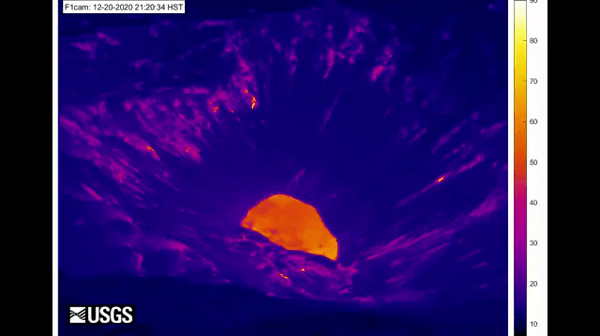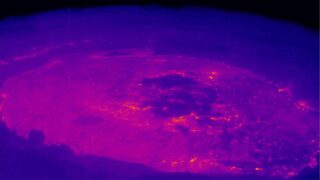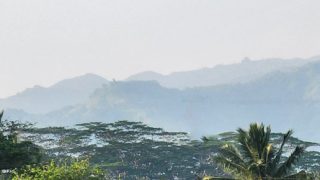The amazing lava flows from Kilauea at Hawaii Volcanoes National Park are highly visible once again per the photo above, courtesy of USGS. A new eruption in the Kīlauea caldera started Wednesday afternoon. Recent eruptions fed lava into a growing lake and belching steam into the sky earlier this year. We find that the best place to keep track of what’s happening with the flow is via the USGS Twitter feed. A post this afternoon read, “#Kilauea #volcano summit #eruption is in full swing. What was once a cooling lava lake is now a new fissure eruption!”
Head to the bottom for a fascinating video of the 2018 eruption and tips on visiting the park now.
September 29, 2021 Eruption at Hawaii Volcanoes National Park.
Kīlauea volcano erupted again, starting at 3:20 pm when the USGS Hawaiian Volcano Observatory (HVO) first observed a glow in the Kīlauea summit webcam images. The eruption occurred within the Halemaumau crater in the Kīlauea summit caldera, within Hawaii Volcanoes National Park. Imagery indicated fissures at the base of the crater generating lava flows on the surface of the lava lake that previously was active until May.
Kilauea Volcano Alert Elevated to Red.
The USGS Hawaiian Volcano Observatory elevated Kīlauea’s alert level from a watch to warning status, with an aviation warning code color changed from orange to red. That is due to the latest eruption while potential associated hazards are being evaluated. The activity is currently confined to Halemaumau. Stay tuned for further updates on the fast-changing situation.
The prior watch status meant that the “volcano is exhibiting heightened or escalating unrest with increased potential of eruption, timeframe uncertain or eruption is underway but poses limited hazards.” The new warning status means that “hazardous eruption is imminent, underway, or suspected.” At present, the eruption is entirely confined within the closed area of Hawaii Volcanoes National Park.
The volcano observatory said that it “will continue to monitor Kīlauea volcano closely and will issue additional messages as warranted by changing activity.”
USGS indicated that “high levels of volcanic gas are the primary hazard of concern, as this hazard can have far-reaching effects downwind. Large amounts of volcanic gas—primarily water vapor (H2O), carbon dioxide (CO2), and sulfur dioxide (SO2)—are continuously released during the eruptions of the Kīlauea Volcano. As SO2 is released from the summit, it will react in the atmosphere to create the visible haze known as vog (volcanic smog) that has been observed downwind of Kīlauea. Vog creates the potential for airborne health hazards to residents and visitors, damages agricultural crops and other plants, and affects livestock.”
Vog has been an ongoing hazard here in Hawaii. The worst situation we remember occurred starting in 2007. See more on Hawaii’s unique vog below.
Other hazards include “Pele’s hair” and Pele’s tears (defined below) and other volcanic fragments. Strong winds can spread those far afield.
Other potential hazards include “crater wall instability, ground cracking, and rockfalls that can be enhanced by earthquakes within the area closed to the public. This underscores the extremely hazardous nature of the Kīlauea caldera rim surrounding the Halemaumau crater, an area that has been closed to the public for nearly 15 years.
Notice for visitors to Volcanoes National Park.
Visitors should monitor the park website. They should also be aware that when winds come from the south, there is now a potential for volcanic ash made up of volcanic glass and rock pieces. These ashfalls represent a minor hazard, but visitors should be aware that dustings of ash at areas around the Kīlauea summit are possible.
Potential for vog returning.
It’s been almost fifteen years since the worst of the vog blanketed the entire state. There is no indication that will happen again, but it is also unknown. The last time, it went on for years and we feared it would remain part of the Hawaii landscape forever. It emanated then too from Mt. Kilauea, which sits 250 miles south of Kauai. It nonetheless traveled that far and with such intensity that it delivered the look and feel of real smog. At the time, the volcano was said to have belched more acid-rich pollution than the dirtiest of US power plants had in the past quarter-century. At times you couldn’t see even a short distance as Kilauea was spewing close to 10 million pounds of sulfur dioxide into the air daily.
Then the vog finally cleared and it has great overall, both on the Big Island and throughout Hawaii. Visibility has been excellent. Air quality went from being a detriment on the Big Island to a quality feature.
Vog’s health effects. For the past two decades, researchers headed by the University of Hawaii medical school have studied the impact of Hawaii’s vog. Interesting to us, vog from every volcano is unique. Kilauea vog is renowned for an almost pure sulfur dioxide output. More long-term research is needed to accurately determine the health risks associated with Kilauea’s vog.
Luckily, prevailing trade winds keep the vog off the south shore of the Big Island and away from the rest of the state most of the time. Unlike seasonal weather patterns, however, wind direction changes are not predictable. Once a pattern is established, it can continue for a week or more.
What are Pele’s hair and Pele’s tears?
“Pele’s hair” is the volcanic glass fibers formed by the molten lava flow. It is often carried by wind (which we expect this week) and can travel miles from the source. These fibers are sharp, brittle, and can cut into the skin.
“Pele’s tears” are pieces of cooled lava drops that are formed as airborne particles of molten eruption fuse into tear-shaped pieces of volcanic glass. These black tears are often seen at the end of Pele’s hair.


The Eruption of 2018.
More than 700 homes were destroyed and thousands of residents had to evacuate in 2018 when Kilauea volcano again erupted, spewing rivers of lava and molten rock over rural districts on the Big Island. Thgat changed the island forever when for a period of four months, large lava flows covered land southeast of the park and destroyed residential areas in the Puna District. There were also tens of thousands of earthquakes, a massive collapse of the Kilauea caldera, and towering plumes of ash.
See the fascinating USGS video of that eruption below.
Visiting Hawaii Volcanoes National Park.
If you choose to visit, be sure to refer to their website for current updates. Visitor services are limited but most of the park is open. Private vehicle entrance costs $30.
1. Trails are open but hours have not been updated.
2. Bring a flashlight in case you return in dark conditions.
3. Restrooms are open but limited.
4. The Kilauea visitor center bookstore, lanai, and restrooms are open (exhibits and theater are closed). Rangers and volunteers are available to provide the latest information on the eruption, hiking information, things to do, and the daily schedule of ranger-led activities. You can also call them at 808-985-6011. The Kahuku Unit is open Thursday through Sunday from 9 am to 4 pm.
5. Bring your own food and water. No potable water is available in the park.
6. Large busses more than 26′ long are not allowed in the park.
Prior Hawaii Volcanoes National Park Prior Lava Flow From the Water.
A few years ago, we were able to sail by a prior lava flow from a ship, as you can see in this Beat of Hawaii photo. It was a completely moving experience to witness Pele as we watched, listened, and smelled her power.


Featured image and GIF courtesy of USGS.
Updated 9/30/21.
Get Breaking Hawaii Travel News







In Ka’u we have not had an issue with vog so far. As always it will depend on wind direction and the amount of emissions spewing out of Kilauea.
Kona and the Kohala coast usually have it much worse than those of us in the south part of the island.
[You have been banned]
Aloha. Thanks for the update. So after waiting and waiting for Covid to improve, I finally booked a first trip to the Big Island yesterday for early December and I get this news today. We are spending several days in Volcano hoping to explore the park. I will be thrilled to see lava but also hope it doesn’t affect our ability to explore or have to deal with vog. I guess mother nature will determine our itinerary. Thanks again for the information.
Hi Tammy.
Thanks. Yes, we too hope the vog will not be an issue.
Aloha.
I flew in yesterday and saw the cloud formations it caused. It was amazing. Got some great pics!
Aloha BOH Bro’s
VOG! That’s the straw that brakes my Camels back!!!
Covid, covid testing, covid vaccine, masking, 50 percent restaurant cap and sky rocket rental car fees, I’m drawing the line at VOG!
OH wait next week I’m going to be on Maui not BI.
Trip back on!!!
You do know that Vog travels to Maui, it’s neighboring island? One reason we opted not to retire on Maui. Loved Up Country & the Kula area but Vog is a serious health issue for area wide residents
My luck…this happened the day after I left. Hopefully it will still be flowing in a few months, when I get back. I did not get enough video this last trip. Hope to get more in Feb/March…
Mahalo for the update guys!
Hi Jim.
We look forward to catching up with you. One of these times will work.
Aloha.
Aloha
This year while on the Big Island, can’t help but notice a good many road repairs on the windward side of the island. Mostly in the volcanic areas.
Mahalo Guys
I wanted to give Hawaii two big thumbs up for the way our flight there was handled. We had our safelflight info uploaded and we breezed through the first check point, as well as the covid testing. Even more amazing was how they handled my 22 year old son’s special exemption. He had developed Covid 2 1/2 weeks prior to his flight and they told him he would be testing positive for up to 3 months. But he was told that if he got a report from his doctor saying that he was symptom-free and fully recovered 11 days after his positive test, he could get an exemption from the attorney general’s office. They expedited his request so that he could join us here on the Big Island. We were all very grateful and impressed with the way the attorney generals office and the Big Island checkers handled his entry into Hawaii.
Any word on what the next island will be called? I read the island forming under the ocean is now larger than the Big Island. Holy moses!!
It already has a name. Loihi From Wikipedia:
Lōʻihi Seamount (also known as Lōihi) is an active submarine volcano about 22 mi (35 km) off the southeast coast of the island of Hawaii.[5] The top of the seamount is about 3,200 ft (975 m) below sea level
On one of our first visits to the Big Island, lava was flowing in a very accessible and visible location, and had been flowing for some weeks, so we planned to see it at the end of our trip. But, the visible flow stopped before we could see it! Lesson learned. When we were there in the summer of 2018, we didn’t take any chances on missing the eruption, so we booked a helicopter tour. I now know that helicopter noise was an issue for residents, and it was sad to see the destruction to so many people’s homes, but to witness the power of that flow was amazing.
I was able to walk out to the flowing lava back in 2004 after about a 3 mile hike – totally awesome! I’ve wanted to bring my husband back to see it since then, but the BI trips I’ve made since then have always been with other people – not him. Now that it’s flowing again, I’m hoping to get him out there soon!
I was lucky to have seen the eruption by cruise ship a few years back. Awesome to say the least,
Aloha
Aloha! Hopefully Pele’s return is a good sign that Hawaii is turning the corner. Some Hawaiian normalcy.
Mahalo for all you do.
We rescheduled our Big Island trip for July 2021 and I’ve always wanted to see an active lave flow….but just happy to be able to come visit and take in the aloha if it’s stopped by then.
We are due to go to the Big Island in July also. Let’s hope the Covid problems settle down by then! Aloha!
Glad to see that you took the NCL Cruise. I took the same cruise a little over a year ago, about 4 months after it was refurbished. The ship was great and a very nice staff. The food was great, we upgraded to their plan to use the upgraded restaurants instead of the basic restaurants, we heard a lot of complaints from others that they were disappointed with the basic restaurants.
The other thing that really disappointed me is, I like to do landscape photography and was looking forward to photographing the POLY COAST line on the last day, so we got a balcony stateroom and were told when booking that the ship would go up the coast on one side then turn around and go back down the coast on the other side so that both sides of the ship would get a great view of the coastline. So I setup my camera equipment on the balcony, we were on the Port Side (which the crew told me would be the second side to view the coast line). When we went down the coastline the Starboard side of the ship, we went up top and used our iphone and point ad shoot cameras to get some basic shots.
Then when the ship turned around it did not go down the coast as we had been told but went directly out to sea for the trip to Honolulu. I was upset that I was not able to get good photos of the Poly coast after being told that they would do it on both sides of the ship. I asked one of the officers why they did it that way, and he told me that they always go out to sea on the turn around, he said that you can still see the coast from the Port side its just that you are no longer as close to the shore and it is fading in the distance, but they consider that being able to see the coast from both sides of the ship.
Did you folks notice this same thing on your trip that the ship does not go down the coast on both sides? I find it very disappointing that they tell people that they go down the coast on both sides and must be doing this to sell the balconies on both sides of the ship.
In your review I hope you bring up this poor way of defining how they view the Poly coast line
Thanks Art.
That cruise has never “turned around” after the Napali as far as we know (having done it before) but has always gone out to sea gradually from there. Sorry someone (agent or NCL) didn’t explain that to you and we will mention sides of the ship when we next review it. We did find in talking with agents that they weren’t super knowledgeable about certain aspects of the cruise, such as this.
Aloha.
Aloha,
I saw you replied to my email I sent you about a week ago–Thank You. However, just when I saw you had replied–my computer quit. It is back up, but I cannot find your email to me so I can read it.
I don’t know if it is possible or not, but can you please see if you can find it and send it to me again?
Mahalo for your time.
Guy
Hi Guy.
No problem. This link should get you right to your comment and our reply. https://beatofhawaii.com/hawaiian-airlines-may-be-nearing-pilot-strike/comment-page-4/#comment-23092
Aloha.